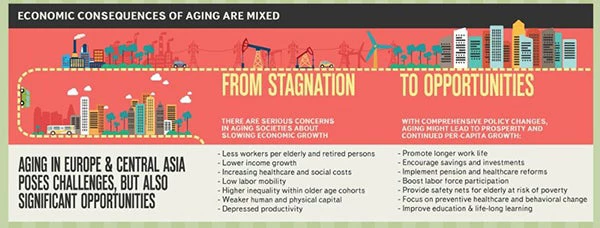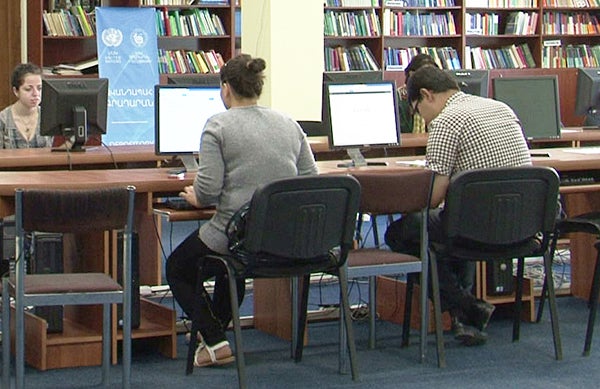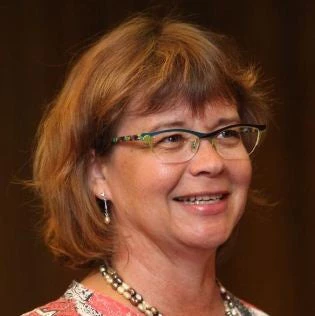“You can’t hold back time,” goes the saying (and the song). Indeed, the Laws of Nature dictate that people and societies get older and older, whether we like it or not.
But let me pose a question: are aging societies doomed to experience stagnation or a decline in living standards? Some might believe so, but I would argue that it is possible to address the realities of changing demographics that come from aging – through bold adaptive action!
Action needs to focus on the untapped potential of all people. For instance, action can be taken to build the cognitive skills needed for older adults’ employment during longer working lives. Action can also be taken to shift social norms and alter labor market institutions to allow women to reconcile family and career goals, and to allow older people to work more flexible hours.

Let’s get specific and take Armenia – where I currently live and work – as an example. Here are four dynamics where migration, aging, and the unequal playing field for women and men put Armenia’s economic growth at risk over the next 20 years:
To address the challenges of the aforementioned dynamics, Armenia will need an “all hands on deck” approach, using all of its human resources – women and men – in as flexible and assertive a way as possible.
So, in a country with such a rich scientific tradition and a creative and modern IT sector, what’s happening in the areas of science, technology, engineering, and mathematics – or STEM?
The challenges faced by Armenia mirror the regional context. Women fill close to half of all jobs in many economies of the Europe and Central Asia region – but we see a very small share of female employment in STEM-related jobs. We know that Armenian students, both girls and boys, can achieve impressive results in programs that support them to learn relevant skills, and then move into jobs where employers and families both value their contribution.
So why would it make sense to focus on STEM?

Good for women, good for the economy
STEM jobs are increasingly in demand in the global economy. A strategy that supports Armenian women and men alike to succeed in STEM jobs can therefore advance both the country’s economy and individual workers. Let’s look at four reasons why this makes sense…
Demand. Employment of STEM-skilled labor is increasing, and is expected to continue growing, primarily due to rising demand for specific products and the replacement of retiring workers. Indeed, this sector was less affected than others by the global financial crisis of 2009-2010.
Skills Growth. ICT-oriented jobs can offer much better growth opportunities compared to currently stereotypical “female jobs”. Jobs in STEM offer the chance to build skills that are transferable not only within that field, but also to other sectors.
Flexibility. STEM jobs often have the potential to offer flexible hours and locations, which helps women to balance household and professional responsibilities. STEM also offers a range of self-employment options.
Pay. Jobs in STEM pay more. And gender wage gaps in these occupations are lower than in other sectors.
Next month, I’ll explore in more depth our recent research on STEM education and jobs in Armenia’s labor market. It will be interesting to see how Armenia could adapt to these dynamic new realities. Stay tuned!
But let me pose a question: are aging societies doomed to experience stagnation or a decline in living standards? Some might believe so, but I would argue that it is possible to address the realities of changing demographics that come from aging – through bold adaptive action!
Action needs to focus on the untapped potential of all people. For instance, action can be taken to build the cognitive skills needed for older adults’ employment during longer working lives. Action can also be taken to shift social norms and alter labor market institutions to allow women to reconcile family and career goals, and to allow older people to work more flexible hours.

Let’s get specific and take Armenia – where I currently live and work – as an example. Here are four dynamics where migration, aging, and the unequal playing field for women and men put Armenia’s economic growth at risk over the next 20 years:
- Demographic shifts will result in a predominantly female elderly population (60%), for which pensions and social safety net systems are not yet prepared.
- A shrinking labor force and steady outmigration will require policies such as childcare provision that will enable women to enter and then remain in the labor force.
- Productivity growth is constrained by the quality and quantity of tertiary education. Although women are the majority of students in higher education, they are less likely to pursue careers in science, technology, engineering, and mathematics.
- Women tend not to own businesses, leaving significant entrepreneurial talent untapped in Armenia.
To address the challenges of the aforementioned dynamics, Armenia will need an “all hands on deck” approach, using all of its human resources – women and men – in as flexible and assertive a way as possible.
So, in a country with such a rich scientific tradition and a creative and modern IT sector, what’s happening in the areas of science, technology, engineering, and mathematics – or STEM?
The challenges faced by Armenia mirror the regional context. Women fill close to half of all jobs in many economies of the Europe and Central Asia region – but we see a very small share of female employment in STEM-related jobs. We know that Armenian students, both girls and boys, can achieve impressive results in programs that support them to learn relevant skills, and then move into jobs where employers and families both value their contribution.
So why would it make sense to focus on STEM?

Good for women, good for the economy
STEM jobs are increasingly in demand in the global economy. A strategy that supports Armenian women and men alike to succeed in STEM jobs can therefore advance both the country’s economy and individual workers. Let’s look at four reasons why this makes sense…
Demand. Employment of STEM-skilled labor is increasing, and is expected to continue growing, primarily due to rising demand for specific products and the replacement of retiring workers. Indeed, this sector was less affected than others by the global financial crisis of 2009-2010.
Skills Growth. ICT-oriented jobs can offer much better growth opportunities compared to currently stereotypical “female jobs”. Jobs in STEM offer the chance to build skills that are transferable not only within that field, but also to other sectors.
Flexibility. STEM jobs often have the potential to offer flexible hours and locations, which helps women to balance household and professional responsibilities. STEM also offers a range of self-employment options.
Pay. Jobs in STEM pay more. And gender wage gaps in these occupations are lower than in other sectors.
Next month, I’ll explore in more depth our recent research on STEM education and jobs in Armenia’s labor market. It will be interesting to see how Armenia could adapt to these dynamic new realities. Stay tuned!


Join the Conversation